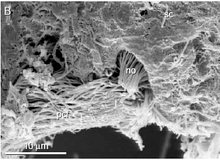Nuchal organ

The Nuchal organ (no). Source: [1]
The nuchal organ is a ciliated pit[2] or groove present at the posterior end of the prostomium of annelid worms,[2] some cephalopods,[3] and other invertebrates.[4]
Annelids only possess one nuchal organ, although the nature of the grooving may make it appear to be a pair of organs.[5]
It may be involved in light detection,[3] and may have a role on food detection and mating.[6]
References
- ↑ Hessling, R.; Purschke, G. #X. 0. F. ;N. (2000). "Immunohistochemical (cLSM) and ultrastructural analysis of the central nervous system and sense organs in Aeolosoma hemprichi (Annelida, Aeolosomatidae)". Zoomorphology. 120 (2): 65. doi:10.1007/s004350000022.
- 1 2 Hessling, R.; Purschke, G. (2000), "Immunohistochemical (cLSM) and ultrastructural analysis of the central nervous system and sense …" (PDF), Zoomorphology, 120 (2): 65–78, doi:10.1007/s004350000022
- 1 2 Parry, M. (2000), "A description of the nuchal organ, a possible photoreceptor, in Euprymna scolopes and other cephalopods", Journal of Zoology, 252 (2): 163–177, doi:10.1111/j.1469-7998.2000.tb00612.x
- ↑ (PDF) http://www.iii.to.cnr.it/pubblicaz/JL_66_2/PENALVA.pdf Missing or empty
|title=(help) - ↑ Purschke, G.; Wolfrath, F.; Westheide, W. (1997), "Ultrastructure of the nuchal organ and cerebral organ in Onchnesoma squamatum (Sipuncula, Phascolionidae)", Zoomorphology, 117: 23, doi:10.1007/s004350050026
- ↑ Schlötzer-schrehardt, U. (1986), "Ultrastructural investigation of the nuchal organs ofPygospio elegans (Polychaeta). I. Larval nuchal organs", Helgoländer Meeresuntersuchungen, 40 (4): 397, doi:10.1007/BF01983820
This article is issued from
Wikipedia.
The text is licensed under Creative Commons - Attribution - Sharealike.
Additional terms may apply for the media files.